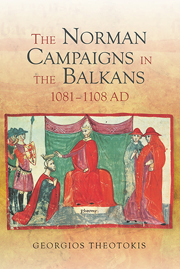Book contents
- Frontmatter
- Contents
- Acknowledgements
- List of abbreviations
- Map I Southern Italy and Sicily
- Map II The island of Sicily
- Map III The southern Balkan peninsula
- Genealogical table: The Norman dukes
- Dedications
- Introduction
- 1 Primary Sources and the Problems of Military History
- 2 Norman Military Institutions in Southern Italy in the Eleventh Century
- 3 The Byzantine Army of the Tenth and Eleventh Centuries
- 4 The Byzantine Naval Forces of the Tenth and Eleventh Centuries
- 5 The Establishment of the Normans in Southern Italy and Sicily
- 6 Robert Guiscard's Invasion of Illyria
- 7 The Norman Advances in the Balkans and the End of the Dream
- 8 Bohemond of Taranto and the First Crusade
- 9 The Count's Campaign of 1107 and the Treaty of Devol
- Conclusions
- List of Byzantine Emperors
- The Hauteville family
- Glossary
- Bibliography
- Index
5 - The Establishment of the Normans in Southern Italy and Sicily
Published online by Cambridge University Press: 05 October 2014
- Frontmatter
- Contents
- Acknowledgements
- List of abbreviations
- Map I Southern Italy and Sicily
- Map II The island of Sicily
- Map III The southern Balkan peninsula
- Genealogical table: The Norman dukes
- Dedications
- Introduction
- 1 Primary Sources and the Problems of Military History
- 2 Norman Military Institutions in Southern Italy in the Eleventh Century
- 3 The Byzantine Army of the Tenth and Eleventh Centuries
- 4 The Byzantine Naval Forces of the Tenth and Eleventh Centuries
- 5 The Establishment of the Normans in Southern Italy and Sicily
- 6 Robert Guiscard's Invasion of Illyria
- 7 The Norman Advances in the Balkans and the End of the Dream
- 8 Bohemond of Taranto and the First Crusade
- 9 The Count's Campaign of 1107 and the Treaty of Devol
- Conclusions
- List of Byzantine Emperors
- The Hauteville family
- Glossary
- Bibliography
- Index
Summary
Southern Italy before the Normans
Regional strategy is shaped to a great extent by the geography of an operational theatre; hence, the study of the topography of southern Italy is essential for a the better understanding of the factors that affected Norman and Byzantine strategic thinking in the region and for explaining the course of events that unfolded in the decades after the coming of the Normans. Apulia's northern limits are fixed by the lower Fortore River, with the area between the Fortore and the Ofanto, known by its Byzantine name of Capitanata (modern Foggia). To the east, the Capitanata forms a fertile lowland peninsula, the Gargano. Situated between the Ofanto and the Brindisi-Taranto line is central Apulia, which is blocked to the west by the southern Apennines.
Most of the cities in Apulia were, and still are, situated on the shoreline, not just for reasons of commerce with other Mediterranean ports, but most importantly because of the rough limestone terrain and the absence of any rivers in the Apulian interior. The Via Appia, one of the oldest and most strategic military roads built by the Romans in the late fourth century BC, connected Rome with Brindisi via the Apulian countryside and along with the Via Traiana, an extension of the Via Appia through Benevento and coastal Apulia, is strategically connected to the Via Egnatia that reached Constantinople. The Basilicata (modern Lucania) between the River Bradano to the north and the Monte Pollino massif in the south is the most mountainous region of southern Italy, an inhospitable terrain with unreliable rainfall and dry rivers for half the year. Finally, the Terra d'Otranto (modern Lecce province) is a rock of limestone that divides the Adriatic from the Ionian Sea.
- Type
- Chapter
- Information
- The Norman Campaigns in the Balkans, 1081-1108 AD , pp. 103 - 136Publisher: Boydell & BrewerPrint publication year: 2014

